House of Este
| House of Este Casa d'Este (Italian) Haus von Este (German) | |
|---|---|
| Noble family | |
.svg.png) | |
| Parent house | Obertenghi (predecessor) |
| Country | |
| Ethnicity | Italian-German |
| Founded | 951 |
| Founder | Adalberto III Obertenghi |
| Current head |
|
| Final ruler | Francis V of Modena |
| Titles | |
| Style(s) | "His/Her Imperial and Royal Highness" |
| Estate(s) | |
| Deposition | 1859 |
| Cadet branches |
|
The House of Este (Italian: Casa d'Este [ˈɛste]; originally House of Welf-Este) is a European princely dynasty.
The elder, German branch of the House of Este, known as the Younger House of Welf, included dukes of Bavaria and Brunswick-Lüneburg and produced Britain's Hanoverian monarchs, as well as one Emperor of Russia (Ivan VI) and one Holy Roman Emperor (Otto IV).
The younger, Italian branch of the House of Este included rulers of Ferrara (1240–1597), and of Modena and Reggio (1288–1796).
Origins
According to Edward Gibbon, the family originated from the Roman Attii family, which migrated from Rome to Este[2] to defend Italy against the Ostrogoths. However, there is little evidence to support this hypothesis. The names of the early members of the family indicate that a Frankish origin is much more likely. The first known member of the house was Margrave Adalbert of Mainz, known only as the father of Oberto I, Count palatine of Italy, who died around 975. Oberto's grandson, Albert Azzo II, Margrave of Milan (996–1097) built a castle at Este, near Padua, and named himself after the location. He had three sons from two marriages, two of whom became the ancestors of the two branches of the family:
- Welf IV, the eldest (d. 1101), was the son of Kunigunde (d. 1056), the last of the Elder Welfs. He inherited the property of his maternal uncle, Welf, Duke of Carinthia, became duke of Bavaria in 1070, and is the ancestor of the elder branch, the House of Welf.
- Hugh, issue of Azzo's second marriage to Garsend of Maine, inherited the French County of Maine, a legacy of his mother's dowry, but sold it one year later and died without heirs.
- Fulco I, Margrave of Milan (d. about 1128/35), the third son, is the ancestor of the younger Italian line of Este.
The two surviving branches, with Duke Henry the Lion of Saxony and Bavaria on the German (Welf dynasty) side, concluded an agreement in 1154 which allocated the family's Italian possessions to the younger line, the Fulc-Este, who in the course of time acquired Ferrara, Modena and Reggio. Este itself was taken over in 1275 by Padua, and in 1405 (together with Padua) by Venice.
Elder branch, Guelph, Electors of Hanover
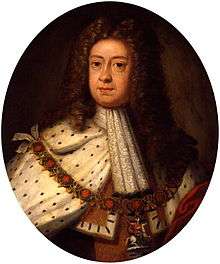
The elder branch of the House of Este, the House of Welf, historically rendered as "Guelf" or "Guelph" in English, produced dukes of Bavaria (1070–1139, 1156–1180), dukes of Saxony (1138–1139, 1142–1180), a German King (1198–1218), the dukes of Brunswick and Lüneburg (1208–1918)(later styled the "Electors of Hanover") when the two branches of the family recombined in 1705. The senior branch of the House of Welf continued to be ruled by the princes of Brunswick-Wolfenbüttel, as undisputed until the death of the ruling duke of Brunswick Prince William VIII, in 1884. Prior to his death, his brother Karl II from Geneva Switzerland, as exiled de jure ruler of the house, had declared the Prussian annexation of the crown and the earlier Hanoverian usurpation absolutely illegal acts of usurpation inside of the German House. At his death, his grandson continued internationally recognized appeals. Hanover formed the Guelph Party (or German Party) to continue political appeals against the Prussian and German annexations of the crown.
After the peace ending the Napoleonic wars reshaped Europe, ushering in the Modern era, the Electorate of Hanover (duchy of Brunswick and Lüneburg, held in personal union by the king of Great Britain, George III) was dissolved by treaty. Its lands were enlarged and the state was promoted to a kingdom. The new kingdom existed from 1815 to 1866, but upon the accession of Queen Victoria (who could not inherit Hanover under Salic law) in 1837, it passed to her uncle, Ernest Augustus, King of Hanover, and thus ceased to be in personal union with the British Crown.
The House of Este gave Great Britain and the United Kingdom the "Hanoverian monarchs" (1714–1901).
.svg.png) Arms of Great Britain (1714–1801)
Arms of Great Britain (1714–1801).svg.png)
.svg.png) Version for Scotland
Version for Scotland
Younger branch, the Margraves of Este
All later generations of the Italian branch are descendants of Fulco d'Este. From 1171 on, his descendants were titled Margraves of Este.
Obizzo I (d. 1193), the first margrave, battled against Emperor Frederick I Barbarossa. His nephew Azzo d'Este VI (1170–1212) became podestà of Mantua and Verona. As the dowry of his niece the Marchesella, Ferrara passed to Azzo VI d'Este In 1146, with the last of the Adelardi. In 1242 Azzo VII Novello was nominated podestà for his lifetime.
The lordship of Ferrara was made hereditary by Obizzo II (d. 1293), who was proclaimed Lord of Ferrara in 1264, Lord of Modena in 1288, and Lord of Reggio in 1289. Ferrara was a papal fief and the Este family were given the position of hereditary papal vicars in 1332.
Ferrara became a significant center of culture under Niccolò d'Este III (1384–1441), who received several popes with great magnificence, especially Eugene IV. He held a Council in Ferrara in 1438, later known as the Council of Florence.
His successors were his ilegitimate sons Leonello (1407–1450) and Borso (1413–1471), who was elevated to Duke of Modena and Reggio by Emperor Frederick III in 1452, receiving these duchies as imperial fiefs. In 1471, he received the duchy of Ferrara as papal fief from Pope Paul II, for which occasion splendid frescoes were executed at Palazzo Schifanoia.
Borso was succeeded by a half-brother, Ercole (1431–1505), who was one of the most significant patrons of the arts in late 15th and early 16th century Italy. Ferrara grew into a cultural center renowned especially for music; Josquin des Prez worked for Duke Ercole, Jacob Obrecht came to Ferrara twice, and Antoine Brumel served as principal musician from 1505. Ercole's daughter Beatrice (1475–1497) married Ludovico Sforza, Duke of Milan; another daughter, Isabella (1474–1539), married Francesco Gonzaga, Marquess of Mantua.
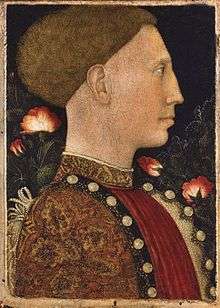

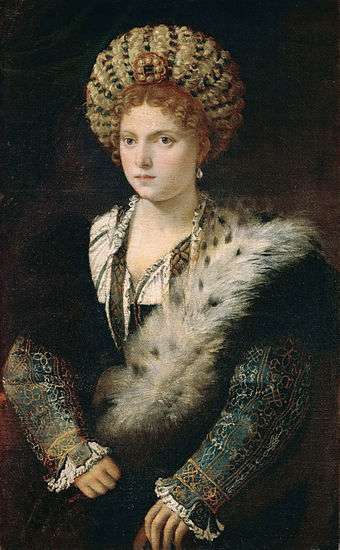 Isabella d'Este, portrait by Titian
Isabella d'Este, portrait by Titian
Ercole I's successor was his son Alfonso I (1476–1534), third husband of Lucrezia Borgia, daughter of Pope Alexander VI, sister to Cesare Borgia. Alfonso I was a patron of Ariosto.
The son of Alfonso and Lucrezia Borgia, Ercole d'Este II (1508–1559), married Renée of France, daughter of Louis XII of France. His son Alfonso II first married Lucrezia, daughter of grand-duke Cosimo I of Tuscany. After she died, he married Barbara, the sister of Maximilian II, Holy Roman Emperor (1527–1576). His third wife, Margherita Gonzaga, was daughter of the duke of Mantua.
Ercole raised the glory of Ferrara to its highest point, continuing the patron of Torquato Tasso and Giovanni Battista Guarini and in general favoring the arts and sciences, as the princes of his house had always done. The legitimate line ended in 1597 with him; as his heir, Emperor Rudolph II recognized his first cousin Cesare d'Este (1533–1628), member of a cadet branch born out of wedlock, who continued to rule in the imperial duchies and carried on the family name. Ferrara, on the other hand, was annexed by force of arms in 1598 by Pope Clement VIII on grounds of the heir's illegitimacy and incorporated into the Papal States.
The last duke, Ercole III, was deposed in 1796 by the French. His two duchies became the Cispadane Republic which one year later was merged into the Cisalpine Republic and then into the Napoleonic Kingdom of Italy. Ercole was compensated in 1801 with the small principality of Breisgau in southwestern Germany, whose previous rulers, the Habsburgs, ceded it to him in anticipation of its eventual return to the Habsburgs, since Ercole's daughter Maria Beatrice Ricciarda d'Este was married to a cadet Habsburg, Archduke Ferdinand of Austria-Este. Ercole died in 1803 and Breisgau passed to his daughter and her husband, who in 1806 lost it during the Napoleonic reorganization of the western territories of the defunct Holy Roman Empire to the enlarged and elevated Grand Duchy of Baden.
- Castello Estense in Ferrara
 Ducal Palace in Modena, built in 1634 by Francesco I d’Este
Ducal Palace in Modena, built in 1634 by Francesco I d’Este
Austria-Este and the House of Habsburg
The Este Orioles House and Ercole III, Duke of Modena
The 30th of October 1798, the legitimate descendant of the Family Este Orioles, Antonino of Este Orioles, received a “Provvedimento di Giustizia" ( countersigned by the Marquis Gherardo Rangone -the Interior Minister of the House of Este[3]) from the Duke of Modena Ercole III of Este,who was in exile in Venice. Ercole III granted him and the House of Este Orioles the Ducal Title and all its prerogatives. The current head of the House of Este Orioles is Duke Antonino V ; Ercole III "Provvedimento di Giustizia" is kept in the Heraldic Heritage archive of the Serenissima Ducale e Comitale Casa d’Este Orioles.
In 2013, the Italian Judiciary -via Pronouncement[4], ascertained that Antonino V of Este Orioles descends from Antonino I Este Orioles who received the Provvedimento di Giustiziaand all the prerogatives connected to it. The Pronouncement states: “S.A.S Don Antonino V of Este Orioles (the legitimate successor) has the sovereign prerogatives of the Jus Majestatis and the Jus Honorum; He also holds the titles of Duke, Count and Lord of San Giuliano, Baron of San Piero and Forestavecchia and that of Principe of Castelforte; He has also an International legal entity status as agnate in collateral line of the Estense dynasty, which was Sovereign and already ruling the Duchy of Modena at the time of Ercole III Provvedimento di Giustizia"[5][6].
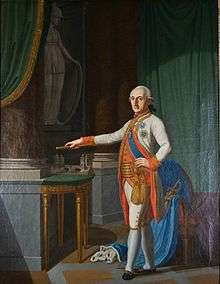
Gallery
 The House of Este held the city Este until 1240, when they moved their capital to Ferrara
The House of Este held the city Este until 1240, when they moved their capital to Ferrara.svg.png) Original Coat of Arms of Este 1239–1431
Original Coat of Arms of Este 1239–1431.svg.png) Coat of Arms of Este 1431–1452
Coat of Arms of Este 1431–1452.svg.png) Coat of arms of Este 1452–1471
Coat of arms of Este 1452–1471.svg.png) Coat of Arms of Este in 1471
Coat of Arms of Este in 1471.svg.png) Coat of Arms of Este 1471–1535
Coat of Arms of Este 1471–1535.svg.png) Coat of Arms of Este 1535–1741
Coat of Arms of Este 1535–1741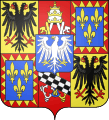 Coat of Arms of Este in 1741
Coat of Arms of Este in 1741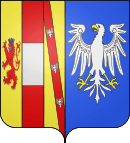 Coat of Arms of Austria-Este
Coat of Arms of Austria-Este Arms of Austria-Este as borne by Archduke Franz Ferdinand
Arms of Austria-Este as borne by Archduke Franz Ferdinand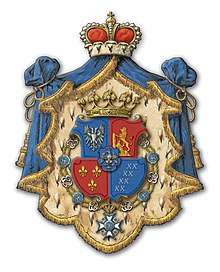 Coat of Arms of D' Este Orioles House
Coat of Arms of D' Este Orioles House.jpg) Provvedimento di Giustizia (Ercole III-Duke of Modena, 1798)
Provvedimento di Giustizia (Ercole III-Duke of Modena, 1798).jpg) Duke Antonino I of Este Orioles (1798)
Duke Antonino I of Este Orioles (1798) Este Orioles Genealogical Tree (Savoy period-1922)
Este Orioles Genealogical Tree (Savoy period-1922)
See also
- Bradamante and Ruggiero, legendary ancestors of the House of Este
- Castello Estense
- Duchy of Ferrara
- Duchy of Reggio
- Duchy of Modena and Reggio
- Duchy of Massa and Carrara
- Ferrara
- Galleria Estense
- Ivan VI of Russia
- List of Dukes of Ferrara and of Modena
- List of members of the House of Este
- Este
- Modena
- Reggio Emilia
- Romagna
References
- ↑ Tausin, Henri (1878). Dictionnaire des Devises historiques et héraldiques. B. Dumoulin. p. 386.
- ↑ The miscellaneous Works of Edward Gibbon Vol 3 page 172
- ↑ C.f. Venturi, Giambattista (1818) "Memoria intorno alla vita del Marchese Gherardo Rangone"
- ↑ These types of judicial pronouncements are not rare; for instance Cf. D’ Altavilla (D’Hauteville) Sicilia Napoli : Cassazione, Sezione Terza Penale, Udienza Pubblica, Sentenza nr. 2008 del 23 aprile 1959, Sezione Terza Penale, R.G. nr. 3909/59. Even if Nobility was abolished in Italy, former Dynastic Houses retain the Jus Majestatis and Fons Honorum as long as they never suffered Debellatio.
- ↑ C.f. The citation is taken from the Judicial Pronouncement (Summary; the judicial paper is 12 pages) uploaded on the website of the Apulia (Puglia) Regional Government. The Judicial Pronouncement of the Tribunale (State Tribunal) of the City of Lecce: http://www.regione.puglia.it/documents/10192/10774613/TRIBUNALE.pdf/def6927f-b70e-4cd3-b864-7b8e37ee42d8;jsessionid=C9A0ED98669B6D826B95E0C1D2F12789?version=1.1
- ↑ It is important to clarify that the Duke Antonino V of Este Orioles does not claim the Duchy of Modena as firstly it does not exist anymore and secondly He is a collateral agnate of the Este Family of Modena. It is also important to underline that in Italy the nobility was abolished in 1948; however this does not equate with being outlawed.It means that nobility titles cannot be included in State identity cards and the rights of who hold them is not protected by the State . However the legislation is only one side of the legal system of a country; the other is reflected by “Case laws” and Jurisprudence made by the Italian Judiciary. Currently in Italy there is an ample casuistry about the rights of former Dynastic Families and all support the attribution to these families of the Jus Majestatis (the right to be honored and respected) and Fons Honorum (the right to reward merit and virtue) as these rights are considered linked to the Dynastic families’ Heritage and not to their status to rule a territory. One of the Italian Dynastic families’ De Medici explains quite well this Italian peculiarity. With this in mind, the Judicial Pronouncement of the Tribunale of Lecce should be read and understood.
- Alessandro Cont, "Sono nato principe libero, tale voglio conservarmi”: Francesco II d’Este (1660-1694), “Memorie Scientifiche, Giuridiche, Letterarie”, Accademia Nazionale di Scienze Lettere e Arti di Modena, ser. 8, 12 (2009), 2, pp. 407–459, https://www.academia.edu/6412388/_Sono_nato_principe_libero_tale_voglio_conservarmi_Francesco_II_dEste_1660-1694_
Further reading
- Trevor Dean, Land and Power in Late Medieval Ferrara: The Rule of the Este, 1350–1450.(Cambridge University Press) 1987.
External links

- Il Castello Estense: genealogical tree